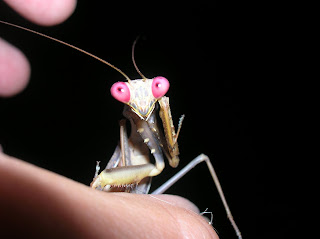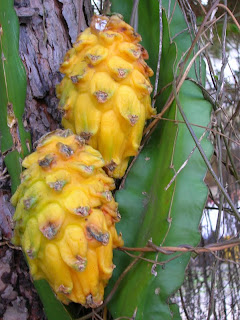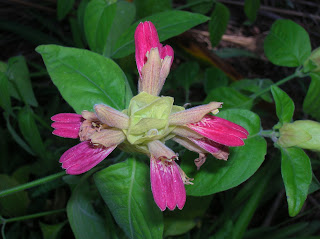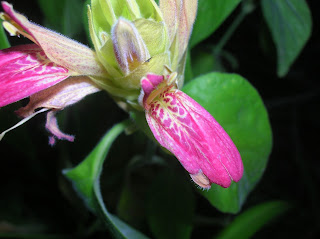

martes, 28 de septiembre de 2010
domingo, 26 de septiembre de 2010
DELONIX REGIA





DELONIX REGIA
Origen: Madagascar
El flanboyán está considerado como el árbol de flor más bello del mundo. Desgraciadamente no soporta el frío y mucho menos las heladas por lo que sólo el hecho de que sobreviva invierno tras invierno ya es un triunfo. En áreas tropicales o subtropicales puede crecer hasta los 12 metros con una copa aplanada que puede alcanzar otros tantos metros de anchura. Aquí en Recregarden es caducifolio perdiendo todas las hojas en invierno. Sus hojas recuerdan a las de un helecho y son muy parecidas a las del jacarandá.
Sólo conozco dos ejemplares en Huelva (adjunto foto de uno de ellos con una solitaria flor) y ambos crecen en puntos más protegidos del frío que Recregarden. Espero que algún día pueda observar un sola flor.
Se reproduce por semillas.
Ya lo he dicho antes, no soporta las heladas, salvo si son muy breves, ligeras y con poca humedad y el ejemplar se encuentra en un punto protegido.
English version:
Origin: Madagascar
Common name: Flanboyant, Royal Poinciana
This tree is perhaps the most beautiful flowering tree in the world. Unfortunately it´s cold sensitive and it doesn´t withstand frosts. For me the only fact of surviving the winter is enough.
It´s a tree that, in tropical or subtropical areas, grows about 12 metres tall with a flat canopy that may be even wider than its height. Here in Recregarden it´s deciduous. Its bipinnate leaves resembles fern fronds.
In the part of Spain where Recregarden is I only know another two specimens (here is a picture of one of them with a solitary flower) and both grow in warmer spots. I hope I will see a single flower one day.
Propagation is easy by seeds. But you need flowers to get seeds without buying them!
I´ve said it before, it´s frost tender.
Etiquetas:
ARBOLES,
NO RESISTENTES,
TENDER,
TREES
sábado, 25 de septiembre de 2010
HEDYCHIUM ELLIPTICUM (Actualización)
HEDYCHIUM ELLIPTICUM (Actualización)
Nuevas fotos de esta planta. Para verlas pincha aquí.
New pictures of this plant. To see them click here.
Nuevas fotos de esta planta. Para verlas pincha aquí.
New pictures of this plant. To see them click here.
viernes, 24 de septiembre de 2010
domingo, 19 de septiembre de 2010
ABELIA X GRANDIFLORA
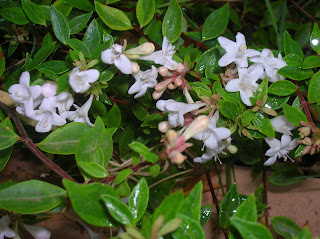




ABELIA X GRANDIFLORA
Origen: es un híbrido entre Abelia chinensis y A. uniflora.
Es un arbusto de tallos semicolgantes que puede alcanzar unos dos metros de altura y de anchura y que ocasionalmente se utiliza como seto de corta altura.
Produce en verano pequeñas flores blancas, aunque hay cultivares que producen flores de color violeta pálido.
Se propaga por esquejes.
Resistente a las heladas.
English version:
Origin: It´s an hybrid between Abelia chinensis and A. uniflora.
It´s a shrub with arching stems that grows to two metres tall and wide. It´s occasionally used for short edges.
It produces in summer small white flowers, although there are cultivars that have mauve flowers.
Propagation is by cuttings.
Frost hardy.
Actualizado a 25/10/2012
Etiquetas:
ARBUSTOS,
HARDY,
RESISTENTES,
SHRUBS
sábado, 18 de septiembre de 2010
HIBISCUS ROSA-SINENSIS (Actualización)
HIBISCUS ROSA-SINENSIS (Actualización)
Nuevas fotos de esta planta. Para verlas pincha aquí.
New pictures of this plant. To see them click here.
Nuevas fotos de esta planta. Para verlas pincha aquí.
New pictures of this plant. To see them click here.
lunes, 13 de septiembre de 2010
SEMILLAS DE STRELITZIA REGINAE


SEMILLAS DE STRELITZIA REGINAE
(STRELITZIA REGINAE SEEDS)
Estas son las primeras semillas de "ave del paraíso" que consigo en Recregarden. Realmente son bonitas, con una "cabellera" de color naranja brillante. Las he plantado y a esperar...
Para ver la ficha y más fotos de esta planta, pincha aquí.
These are the first "bird of paradise" seeds we get in Recregarden. They have a nice looking with strange brilliant orange "hairs" . I´ve sown them and I´m waiting for...
To see this plant profile and more pictures, click here.
domingo, 12 de septiembre de 2010
HYLOCEREUS UNDATUS







HYLOCEREUS UNDATUS
Origen: su origen exacto se desconoce, pues se ha naturalizado en muchos países tropicales. Probablemente su origen sea el Caribe.
Es un cactus trepador, epífito, que puede alcanzar más de 10 metros de altura creciendo sobre un árbol o sobre rocas.
Produce grandes flores blancas que se abren una sola noche, de ahí que sea conocido como "reina de la noche". En Recregarden sólo ha florecido una vez, pero sólo vimos la flor cuando ésta calló seca al suelo.
Produce un fruto comestible (y cultivado en muchos países tropicales) conocido como pitahaya (aunque también se conoce con el mismo nombre al fruto de otras especies del mismo género). Desafortunadamente, los frutos de las fotografías no son de producción propia, sino comprados en un mercado.
Produce un fruto comestible (y cultivado en muchos países tropicales) conocido como pitahaya (aunque también se conoce con el mismo nombre al fruto de otras especies del mismo género). Desafortunadamente, los frutos de las fotografías no son de producción propia, sino comprados en un mercado.
Se reproduce fácilmente por esquejes.
Sólo soporta heladas muy débiles.
English version:
Origin: Uncertain, probably Caribbean region. Naturalized in many tropical countries.
Common name: Queen of the night, Night blooming cactus.
It´s a climbing, epiphytic cactus that may grow more than 10 metres, climbing over a tree or rocks.
It produces very big white flowers that open a single night (hence its common name), followed by edible fruits known as pitahayas widely cultivated in tropical countries (although the same name is used for similar fruits from other species in the same genus). In Recregarden it has bloomed just once but we only saw the flower when it felt down to the floor. Unfortunately fruits of the pictures are not own harvest but bought in a market.
Propagation is easy by cuttings.
It withstands only very light frosts.
Actualizado a 25/11/2016
Etiquetas:
CACTI OR SUCCULENTS,
CACTUS Y CRASAS,
CLIMBERS,
HALF-HARDY,
SEMI-RESISTENTES,
TREPADORAS
sábado, 11 de septiembre de 2010
CYATHEA BROWNII (Actualización)
CYATHEA BROWNII (Actualización)
Nuevas fotos de esta planta. Para verlas pincha aquí.
New pictures of this plant. To see them click here.
Nuevas fotos de esta planta. Para verlas pincha aquí.
New pictures of this plant. To see them click here.
miércoles, 8 de septiembre de 2010
SCHEFFLERA ARBORICOLA








Este arbusto de largos tallos que crecen desde la base y que puede alcanzar 4,5 metros de altura es muy cultivado como planta de interior. No obstante, y a pesar de su aspecto, se adapta muy bien a su cultivo al exterior en un lugar sombrío y resguardado del frío, soportando sin problemas heladas débiles.
Produce unas pequeñas flores verdosas que dan lugar a pequeños frutos de color naranja que se vuelven rojos al madurar.
Se reproduce por esquejes o acodo.
English version:
Origen: Taiwan
Origen: Taiwan
Common name: Hawaiian Elf Schefflera
This shrub, with long stems growing from the base of the plant, can reach 4,5 metres tall and is grown widespread as indoor plant. But, in spite of its tropical looking, it adapts quite well to cultivation in open air in a shady and sheltered place, withstanding light frosts without problems.
It produces little greenish flowers followed by orange fruits that turn to red when ripen.
Propagation is by cutting or air layering.
Etiquetas:
ARBUSTOS,
HARDY,
RESISTENTES,
SHRUBS
domingo, 5 de septiembre de 2010
JUSTICIA BRANDEGEANA






JUSTICIA BRANDEGEANA (sin. Beloperone guttata)
El cultivar tipo de esta planta, más conocida como Beloperone, ya lo presentamos en Recregarden hace un año (pinchar aquí).
El cultivar de hoy, con flores rosadas y bracteas verdosas, tiene unas características y condiciones de cultivo idénticas a las de la especie tipo.
English version:
The profile of the typical cultivar of this plant, better known as Beloperone, was published a year ago (click here).
Now we present a different cultivar with pinkish flowers and greenish bracts. The main features and growing conditions of this cultivar are the same of the typical cultivar ones.
Actualizado a 13/11/2010
Etiquetas:
ARBUSTOS,
HARDY,
RESISTENTES,
SHRUBS
Suscribirse a:
Comentarios (Atom)
